2. 1 INTRODUCTION
The flint material described in this chapter was collected from the site at Locality 122, Palmyra basin. Professor Sakaguchi, physical geographer of the expedition, performed intensive geomorphological surveys in the Sabkhet Mouh areas for the purpose of obtaining the additional data required for the further consideration of the Paleo-Palmyra Lake (Sakaguchi, 1978). During the survey, he found many places characterized by a concentration of flint gravels on the surface. Locality 122 was one of several dozen located by these procedures (see Fig. 1. 2 in this volume).
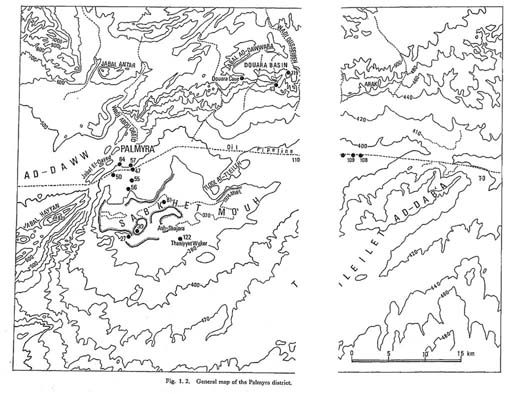
Fig.1.2 |
The collections described here were scattered on the lower lacustrine terrace of Paleo-Palmyra Lake as defined by Sakaguchi (1978; see also Chapter 1 in this volume). Study of the collection, especially of its chronological position, is particularly important because site formation at this location must provide basic information on both the existence of the Paleo-Palmyra Lake and its geomorphological changes over time.
The lithic assemblage identified is markedly simple, and the lithic elements-the navi-form type cores and associated blades-have exhibited linear relationships to one another technologically. The naviform type cores in the collection have the same morphological features as those of the blade cores found in stratified deposits of the PPNB horizon in the Levant. In conclusion, the lithic assemblage collected suggests that this is an archaeological site characterized by a concentration of lithic data in terms of human activities in Pre-Pottery Neolithic B (PPNB) tiroes.
Evidence of this early type Neolithic has increased considerably as a result of recent excavations of Syrian sites at Mureybet (J. Cauvin, 1977), El Kowm (J. Cauvin et al., 1978, 1982), and Abu Hureyra (Moore, 1975), and of technological analyses of surface materials in Palmyra (e.g., Akazawa, 1975, 1979; Abe and Akazawa, 1977; Suzuki and Akazawa, 1971).
Thus, the purpose of this study is to describe the present collection and its relation to relevant assemblages in the Levant. Here we describe the site named as Thaniyyet Wuker.
2.2 THE SITE
Palmyra Basin contains many flint-strewn fields, which are characterized by a concentration of flint gravel on their surfaces. The most important feature of these fields is that, with only a few exceptions, they are usually adjacent to the exposed flint beds. These fields are broadly divided into two types according to the nature of the flint materials scattered in them.
In the first type, the scattered flint specimens did not prove to be of human workmanship. In the second type, hundreds to thousands of pieces definitely classifiable as artifacts were concentrated, together with a certain number of naturally fractured specimens. The concentrations vary in dimension and density (e.g., Akazawa, 1975, 1979; Abe and Aka-zawa, 1977). In comparing the two, it was found that the raw materials were quite different. Flint material of the first type is usually not homogeneous and is easy to break, suggesting that it was not adequate as a raw material for stone tools, while flint of the second type is apparently homogeneous.
Thaniyyet Wuker had been considered one of these flint-strewn field located in Palmyra Basin to date, but in several points it is quite different from the others described above. First, Thaniyyet Wuker is not located adjacent to the flint outcrops in mountain region, but is on a lacustrine deposit with no flint gravels or nodules. Second, every piece of the collection exhibits definite evidence of human workmanship. Thus, it is quite probable that Thaniyyet Wuker was a human habitation site, although it cannot be determined whether the site was occupied only during a particular seasons or all year round.
The site is composed of several locations characterized by flints scattered over a rather restricted area. Each location is broadly oval to circular in outline, four to five meters in maximum diameter. A total of 47 flint artifacts were collected using two different methods: one was to arbitrarily collect specimens throughout the site, and the other was to collect all the specimens from a 1 × 1 m area set up on the site. The specimens have been divided into several types: cores, unmodified blades and flakes, modified blades, by-products of core preparations and blade detachments, and other chips (Table 2. 1). The material described below was from the surface, with no stratigraphic context.
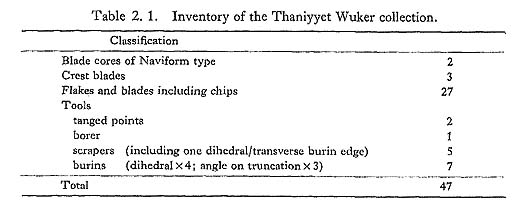
2. 3 DESCRIPTION OF THE COLLECTION
2. 3. 1 Core technique
The most striking feature of the collection is the occurrence of naviform cores and their by-products.
Naviform cores
Two cores of this type were collected. The first one (Fig. 2. 1:2) is characterized by having double and oblique striking platforms at both ends of the long axis and by a broadly trapezoidal outline as seen from the side. The striking platforms were produced by the removal of a core-tablet, as characterized by Mortensen (1970). Over the front of the core a series of parallel and elongated flaking scars run bi-directionally from both platforms, showing the heavy detachment of blade blanks. As a result the core is reduced in size and the preparatory flaking scars, which must have covered the remaining portions, were mostly removed.
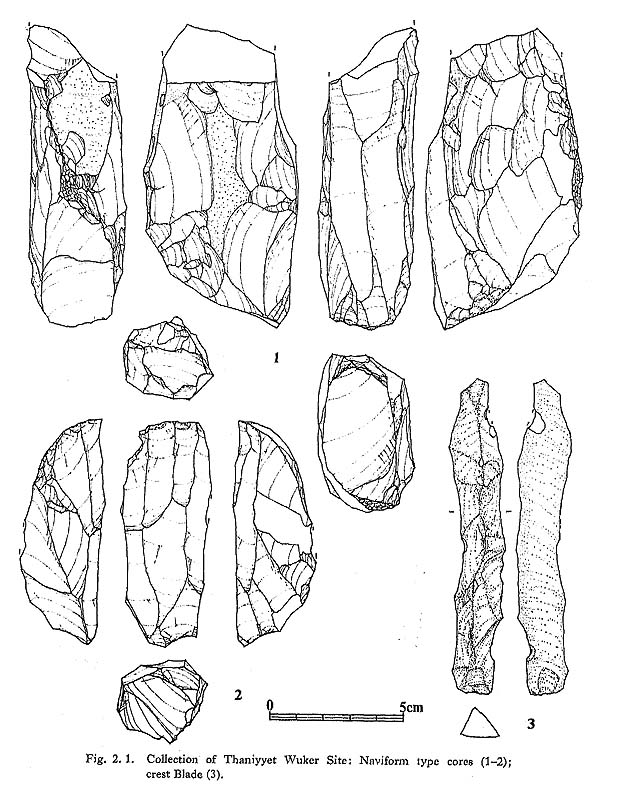
The second core (Fig. 2. 1: 1) is also naviform. Although one end of the long axis was broken, it is evident that the core also has double striking platforms, as seen from a series of parallel and elongated flaking scars of blade detachments running bi-directionally from both ends. The remaining portions of the core were covered with scale-shaped scars for preparatory flaking. The core shows clear marks of battering along the back end, suggesting that it was used for chopping. In contrast to the first core, this specimen still has a patch of original cortex and scale-shaped preparatory flaking scars on the surfaces, suggesting the removal of a limited number of blade blanks.
Blade component
Upon close examination of the blades collected from the site, it was found that several were by-products produced during the preparation of the associated cores of naviform type. The most prominent one is typified by elongated flakes with triangular cross-sections which were designated as crested blades by Mortensen (1970).
The dorsal surface of the first specimen (Fig. 2. 1: 3) is covered with flaking scars struck from the crested ridge along the long axis of the blade. The dorsal surface of the second specimen (Fig. 2. 2: 1) is also covered with flaking scars, but the forms of the dorsal surfaces are quite different on the two sides along the crested ridge of the blade. This is in contrast to the dorsal surface of the first blade which is covered with scars flaked symmetrically on both sides of the ridge. On the second blade, one side has a scries of flaking scars running from the ridge, while the other side is covered with flaking scars struck from the central ridge and the lateral margin.
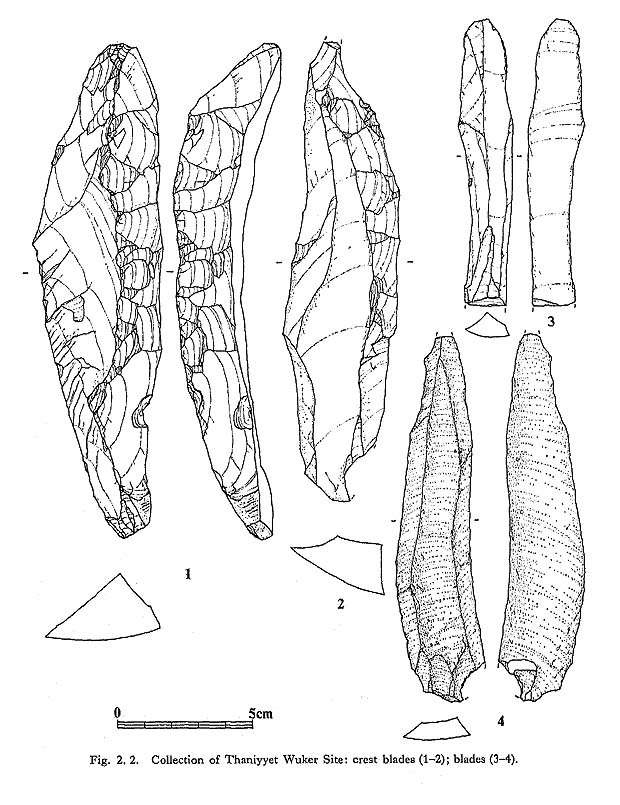
The third specimen (Fig. 2. 2: 2) is also a kind of crest blade. But the type of flaking scar on the dorsal surface is different from that of the other crest blades described above. The most outstanding feature of the blade is that an elongated flaking scar running from the proximal end can be observed in the center of the dorsal surface. This flaking scar was produced after the removal of the "primary crest blade" referred to by Mortensen (1970). The remaining portions of the dorsal surfac aere covered with remnants of core-preparatory flaking scars.
These crest blades were produced through construction and/or widening of the main flaking surface of the core, as shown in several studies (e.g., Mortensen, 1970; Suzuki and Akazawa, 1971). Included in the collection are several elongated, thin blades with parallel edges (Figs. 2. 2: 3-4; 2. 3: 1-2). The dorsal surface is covered with elongated, bi-directional scars running along the main axis of the blade (see Fig. 2. 3: 1-2). These blades were probably produced as tool blanks from a naviform blade core.
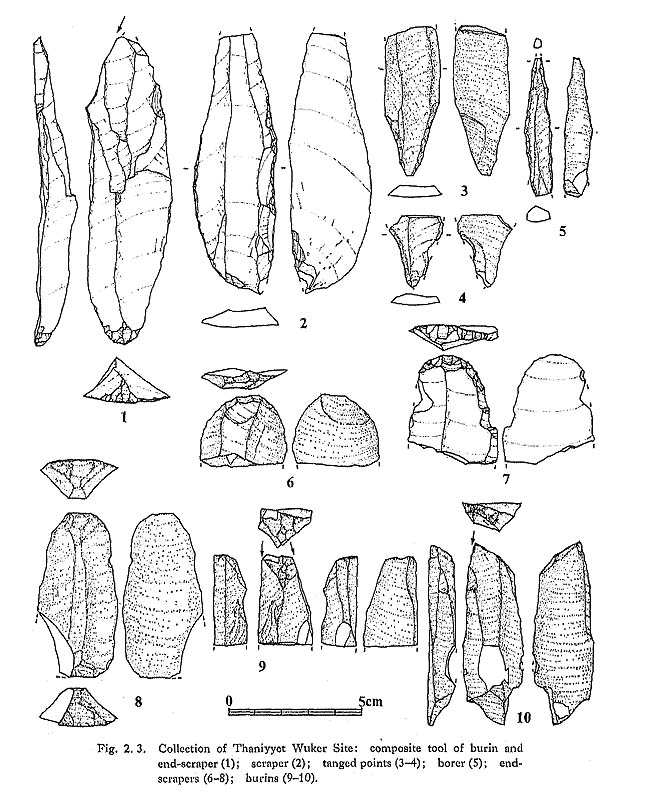
2. 3. 2 Tools
A total of 15 secondarily retouched pieces were collected from the site. The blanks from which these tools were made are classified into two types: blades and flakes. The blade blanks, which occupy the majority in the collection, are characterized by having morphological features on their dorsal surfaces, suggesting that they were removed from the associated blade core of naviform type. These tools are classifiable into several types: points, a borer, scrapers, and burins. The most common type is burins, and the next most frequent is scrapers.
Points
Two points were collected (Fig. 2. 3: 3-4). The tang was formed by a series of obverse, rather steep edge-retouchings along both margins of the proximal part. The remaining portions of the blade are not trimmed, although the distal end is mostly broken off.
These two points are also characterized by a rather flat scar along the left lateral margin on the ventral surface of the tang. It is still uncertain whether these scars are signs of secondary retouching or bulbar scars produced in the blank manufacturing process. Nevertheless, point forms of this kind enable us to compare the Thaniyyet Wuker collection to other relevant assemblages in the Levant, as well be seen in the following section.
Borer
A narrow borer (drill) made on a blade was collected (Fig. 2. 3: 5). Steep retouching is seen on the dorsal surface along both edges. Both distal and proximal ends are snapped off or broken.
Scrapers
Five scrapers are collected, which are divided into two major categories: end-scrapers and side-scrapers. The end-scrapers all have a convex working edge produced by rather steep retouch at the distal (Fig. 2. 3: 1) or proximal (Fig. 2. 3: 6-7) end, or at both ends (Fig. 2. 3: 8).
Included in this group is a side-scraper made on an elongated flake (Fig. 2. 3: 2). Continuous trimming from use or from retouching is apparent on the dorsal surface along the mid-lateral margins. This piece is quite similar to what Mortensen calls a knife (1970: 32-33).
Burins
There are seven burins, the largest tool group in the collection. The burins are classifiable as two major types according to the techniques used in the creation of their cutting edges. The first type is the angle burin on a retouched truncation (Figs. 2. 3: 9-10; 2. 4: 1). This type is defined as having its working edges formed by the intersection of a burin facet with a retouched truncation. The second type is the dihedral burin, characterized by having the working edges created by the diagonal intersection of two burin facets (Fig. 2. 4: 2-5). One of these is a robust type made on a massive blade which was detached from a naviform core (Fig. 2. 4: 3). This type of burin, in addition to the tanged points, is considered to be an important datum for the determinations of the chronological position of the present collection.

One composite tool has two working edges-a burin at one end and an end-scraper at the other (see Fig. 2. 3: 1). The burin edge of this specimen is probably a dihedral or transverse type.
2.4 DISCUSSION
The flint artifacts described in this chapter were all surface materials. In dealing with a collection of this kind, classification can be aided by the physical condition of the flint, for example by its patination color and abrasion. The physical condition of flint varies from place to place and is no sure guide to age determination of surface collections from different locations. However, material from a restricted area would be expected to be quite similar in both patination and abrasion, if it was derived from a single assemblage belonging to a single period.
The collection is notable in that the material is not similar in the degree of patination and abrasion, although coming from a single locality. The collection can be divided into two major groups according to physical condition. The first is heavily abraded and has a dull brown patina (see Figs. 2. 1: 3, 2. 2: 4, 2. 3: 3-7, 9-10). This contrasts with the fine, clean condition and usually whitish color of the flints from the second group (see Figs. 2. 1: 1-2, 2. 2: 2-3, 2. 3: 1-2). Major tools identified-that is, tanged points and burins-are in the definitely more abraded group that has a distinctive patination. Under this evidence, it is still not clear whether or not the present collection was derived from a single assemblage.
Nevertheless, the tanged points and burins described here, which show the same physical condition including patination and abrasion, seem to be linked with each other in the light of recent excavation data from the PPNB sites in the Levant. The same kind of tanged points as those from Thaniyyet Wuker are in the PPNB assemblages of Tell es-Sinn (Roodenberg, 1979/80), Bouqras (Akkermans et al., 1983), Abu Hureyra (Moore, 1979), and Nadaouiych 4 (Cauvin, 1981). Among these are tanged points with a unique scar on their ventral surfaces in the proximal part, especially along the left margin. A robust-type burin included in the tool class has also been found among the burins associated with the PPNB assemblages from the sites of es-Sinn, Bouqras and Abu Hureyra, referred to above.
Examination of the forms and the manufacturing techniques of these points and burins shows an astonishing uniformity. Moreover, the sites concerned are mostly distributed in the middle to upper Euphrates River Basin. This evidence enables us to discuss area-specific inter-assemblage variabilities of the Levantine PPNB industries.
As mentioned in an earlier section, the outstanding feature of the Thaniyyet Wuker collection is the high proportion of burins as secondarily retouched tools. The PPNB and PPNB-related sites, which have extraordinarily high proportions of burins, not equalled by any other lithic assemblage, have been located as burin sites in the inland Levant (e.g., Waechter and Seton-Williams, 1938; Field, 1960; Betts, 1982, 1983, 1984, 1985; Abe and Akazawa, 1977). Another notable characteristic of the burin site is that sickle blades and heavy-duty tools such as mortars, querns, and pestles are either completely absent or negligible in proportion in the assemblages. Thaniyyet Wuker is considered to be one of these burin sites, since it is situated in the inland zone and also lacks sickle blades and heavy-duty tools.
The nature of burin sites remains to be determined. The burins of the related assemblages are quite similar in their techno-typological features; the most dominant tool is usually the angle burin on truncation. But the PPNB collection of Qdeir 1, which is the burin site in El Kowm, inland Syria, is noted for having transverse burins as by far its largest lithic constituent-approximately two-thirds of the total burins (Cauvin, 1981). Another unusual case is the site group whose collection is dominated by dihedral burins as well seen in Thaniyyet Wuker. These peculiar burin sites, in addition to the problem of inter-assemblage variability, must be the object of new studies that will help to explain lithic data in terms of human activities.
It will not be easy to further analyze the present collection and to further characterize the site until excavation of the stratified deposits of the site. Nevertheless, the discovery of the Thaniyyet Wuker site promises a new perspective on the Paleo-Palmyra Lake and its morphological changes over time. Moreover, the dating of the collections can supply the basic data concerning the size of the Paleo-Palmyra Lake.
In comparing the geographical contribution of PPN sites in the Levant, Moore (1982) found that many more sites were inhabited during PPNB (Neolithic 2) than during PPNA (Neolithic 1), and that the distribution pattern was different. The later sites expanded into the inland steppe zone, in contrast to the earlier sites which were at relatively low elevations along the rivers (e.g., Aurenche et al., 1981; Moore, 1982). For instance, around the slopes of the Palmyra basin and many in the caves and rock-shelters in the area, we found a scattering of naviform type cores, the same as those of Thaniyyet Wuker, plus a great number of blades and tools (Suzuki and Kobori, 1970; Suzuki and Akazawa, 1971). This evidence indicates that the inland zone was densely inhabited during PPNB.
The Thaniyyet Wuker find indicates an expansion of settlement into the steppe regions during PPNB. We shall not deal here with all aspects of this phenomena, although we may note that some of the PPNB people who migrated to this region engaged in specific subsistence activities and relied on plant foods and also on animal foods provided by larger hervivores such as Equus, Camelus, Gazella and Caprini. The permanent presence of Paleo-Palmyra Lake suggests that the Palmyra Basin had more plant and shrub cover than today, which would have provided adequate grazing for the larger hervivores.
LITERATURE CITED
- Abe, Y. and Akazawa, T. (1977)
- Burin factory site, Palmyra, Syria. Bulletin of the National Science Museum, Series D (Anthropology), Vol. 3, pp. 1-22.
- Akazawa, T. (1975)
- Douara basin sites: Prehistoric workshop station near Palmyra, Syria. Bulletin of the National Science Museum, Series D (Anthropology), Vol. 1, pp. 11-24.
- Akazawa, T. (1979)
- Flint factory sites in Palmyra Basin. In K, Hanihara and T. Akazawa (eds.), Paleolithic Site of Douara Cave and Paleogeography of Palmyra Basin in Syria (Part II), Univ. Mus., Univ. of Tokyo, Bull. 16: 159-200.
- Akkermans, P. A., Boerma, J.A.K., Clason, A. T., Hill, S. G., Lohof, E., Meiklejohn, C., Miere, Le. M., Molgot, G.M.F., Roodenberg, J.J., Waterbolk-von Rooyen, W., and von Zeist, W. (1983)
- Bouqras revisited: preliminary report on a project in Eastern Syria. Proceedings of the Prehistoric Society, Vol. 49, pp. 335-372.
- Aurenche, O., Cauvin, J., Cauvin, M.-C., Copeland, L., Hours, F., and Sanlaville, P. (1981)
- Chronologic et organisation de l'espace dans le proche orient, de 12000 A 5600 AV. J. C. In Pr é histoire du Levant, pp. 571-601.
- Betts, A. (1982)
- Prehistoric sites at Qa'a Mejalla, Eastern Jordan. Levant, 14, pp. 1-34.
- Betts, A. (1983)
- Black desert survey, Jordan: First preliminary report. Levant, 15, pp. 1-10.
- Betts, A. (1984)
- Black desert survey, Jordan: Second preliminary report. Levant, 16, pp. 25-34.
- Betts, A. (1985)
- Black desert survey, Jordan: Third preliminary report. Levant, 17, pp. 29-52.
- Cauvin, J. (1968)
- Les outlillages n é olithiques de Byblos et du littoral Livanais. Fouilles de Byblos, Vol. IV. Paris.
- Cauvin, J. (1977)
- Les fouilles de Mureybet (1971-1974) et leur signification pour les origines de la sédentarisation au Proche-Orient. Annuals of the American Schools of Oriental Research, Vol. 44, pp. 19-48.
- Cauvin, J. (1981)
- L'Occupation néolithique de la région d'el-Kowm: resultats 1978-1979. In Colloques Internationanx du Centre National de la Recherche Scienlifique, No. 598, Préhistoire du Levant, pp. 471-483.
- Cauvin, J., Cauvin, M.-C., and Stordeur D. (1978)
- Recherches prehistoriques d'El Kowm (Syne): Première campagne 1978. Cahiers de l'Euphrate 2. CNRS.
- Field, H. (1960)
- North Arabian desert archaeological survey, 1925-50. Papers of the Peabody Museum of Archaeology and Ethnology, Harvard University, Vol. 45, No. 2.
- Garrard, A., Byrd, B., Harvey, P. and Hivernel, F. (1985)
- Prehistoric environment and settlement in the Azraq Basin. A report on the 1982 survey region, Levant, 17, pp. 1-28.
- Mortensen, P. A. (1970)
- A preliminary study of the chipped stone industry from Beidha. Acta Archaeologica, Vol. 41, No. 1, pp. 1-54.
- Moore, A.M.T. (1975)
- The excavation of Tell Abu Hureyra in Syria: A preliminary report. Proceedings of the Prehistoric Society, Vol. 41, pp. 50-77.
- Moore, A.M.T. (1978)
- The Neolithic of the Levant, Vols. I and II. University of Oxford, Ph.D. dissertation paper.
- Moore, A.M.T. (1981)
- North Syria in Neolithic 2. In Préhistoire du Levant, pp. 445-456.
- Moore, A.M.T. (1982)
- A four-stage sequence for the Levantine Neolithic, ca. 8500-3750 B.C. Bulletin of the American Schools of Oriental Research, No. 246, pp. 1-34.
- Roodenberg, J. J. (1979/80)
- Sondages des niveaux néolithiques de Tell es Sinn, Syrie. Anatolica, Vol. 7, pp. 21-33.
- Sakaguchi, Y. (1978)
- Palmyra pluvial lake. In K. Hanihara and Y. Sakaguchi (eds.), Paleolithic Site of the Douara Cave and Paleogeography of Palmyra Basin in Syria (Part I), pp. 5-28. Univ. Mus., Univ. of Tokyo, Bull., No. 14.
- Suzuki, C. and Akazawa, T. (1971)
- Manufacturing technique of the stone artifacts from Palmyra, Syria. Journal of the Anthropological Society of Nippon, Vol. 79, No. 2, pp. 105-127.
- Suzuki, H. and Kobori, I. (eds.) (1970)
- Report of the Reconnaissance Survey on Palaeolithic Sites in Lebanon and Syria. Univ. Mus., Univ, of Tokyo, Bull., No. 1.
- Waechter, J. d'A and Seton-Williams, V. M. (1938)
- The excavations at Wadi Dhobai 1937-1938 and the Dhobaian industry. The Journal of the Palestine Oriental Society, XVIII, pp. 172-186.
|